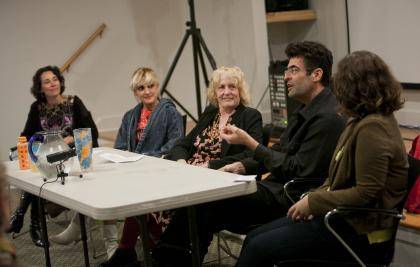
If there's one word Chris Jordan hates, it's "sustainability."
"Words like 'sustainability' are so boring," Jordan, a photographer, said Wednesday night at Duke. "All these sustainable actions -- using canvas bags at the grocery store, not using plastic water bottles -- they're just symbols. Even if everyone in the world did those things, 99.99 percent of the problems associated with environmental degradation would still be there."
Jordan and three other artists, Bryant Holsenbeck, Pinar Yoldas and Hannah Anderson-Baranger, discussed those other problems Wednesday during a panel discussion at the 2013 Duke Arts Festival, which concludes this weekend.
The discussion, moderated by Nicholas School of the Environment faculty member Rebecca Vidra, was held at the Center for Documentary Studies and sponsored by the Office of the Vice Provost for the Arts.
Now in its fifth year, this was the first arts festival with a theme linking the student submissions, said Vice Provost for the Arts Scott Lindroth.
"We wanted to address one of the most pressing social issues with our theme this year," Lindroth said. "This is an issue that we all care about and that students are engaged with through academics, art and activism. We also wanted to show how the arts can lead the multidisciplinary inquiry into [environmental stewardship] on campus."
In addressing the need for more collaboration among artists, scientists and activists, all four artists cautioned against relying on others to fulfill different roles. Rather, said Holsenbeck, artists should see themselves as activists by virtue of what they create.
"I think it's our job to advocate by talking about what we see," said Holsenbeck, whose massive installations usually feature large quantities of plastic bottles. "I don't think advocacy and the arts can exist separately."
During the 2013 Arts Festival, painted pianos are being placed around campus for people to play.
Jordan, whose new film "Midway" uses the plastic-induced deaths of albatrosses in the Pacific to highlight the waste in our oceans, said scientists should stop "hiding behind the screen of objectivity" and start asserting factual findings with more passion.
"Scientists become scientists because they are lovers of the earth," Jordan said. "They can demonstrate their passion for preserving our world without losing objectivity."
Yoldas, who is also a third-year doctoral student in the Visual and Media Studies department, said artists concerned about the environment should ground their creativity in irrefutable knowledge and use emotional triggers to push their audiences to action. Her work, "The Very Loud Chamber Orchestra of Endangered Species," uses animal skulls that appear to "scream" data on endangered species to draw an emotional response from its viewers.
"As artists, we should know the science behind our work," she said. "But we are also able to manipulate emotions to help form these memories."
Though the statistics behind the art -- the millions of tons of plastic waste in our oceans, the many species going extinct each year -- may be bleak, Anderson-Baranger urged attendees not to lose hope.
"There is definitely a point where everyone has felt depressed when they think about the current situation," said Anderson-Baranger, a Duke senior designing her own multidisciplinary degree in sustainable art. "But if, as an artist, I can get one person to think about these issues, then there’s still hope. That's what gets me up in the morning. Otherwise, we'd all just quit."
For more information on the Duke Arts Festival, click here.
Pinar Yoldas' installation "The Very Loud Chamber Orchestra of Endangered Species," can be viewed in the Louise Brown Gallery in the Bryan Center.
Chris Jordan will be discussing his new film "Midway" on Thursday, Oct. 31, at 7:30 p.m. the Nasher Museum of Art.
Bryant Holsenbeck's installation "Falling Water: Plastic Sea" can be viewed in the Bryan Center. Students can also help Holsenbeck install the piece through Nov. 1.